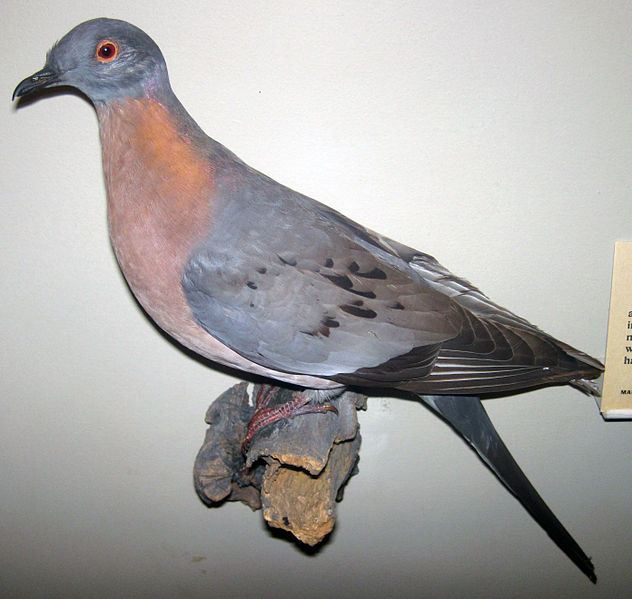படிமம்:Ectopistes migratorius (passenger pigeon).jpg

இந்த முன்னோட்டத்தின் அளவு: 632 × 599 படப்புள்ளிகள் . மற்ற பிரிதிறன்கள்: 253 × 240 படப்புள்ளிகள் | 506 × 480 படப்புள்ளிகள் | 810 × 768 படப்புள்ளிகள் | 1,080 × 1,024 படப்புள்ளிகள் | 2,160 × 2,048 படப்புள்ளிகள் | 2,784 × 2,640 படப்புள்ளிகள் .
மூலக்கோப்பு (2,784 × 2,640 படவணுக்கள், கோப்பின் அளவு: 1.73 MB, MIME வகை: image/jpeg)
கோப்பின் வரலாறு
குறித்த நேரத்தில் இருந்த படிமத்தைப் பார்க்க அந்நேரத்தின் மீது சொடுக்கவும்.
| நாள்/நேரம் | நகம் அளவு சிறுபடம் | அளவுகள் | பயனர் | கருத்து | |
|---|---|---|---|---|---|
| தற்போதைய | 16:39, 2 ஏப்பிரல் 2015 |  | 2,784 × 2,640 (1.73 MB) | FunkMonk | Transferred from Flickr via Flickr2Commons |
கோப்பு பயன்பாடு
பின்வரும் பக்க இணைப்புகள் இப் படிமத்துக்கு இணைக்கபட்டுள்ளது(ளன):
கோப்பின் முழுமையான பயன்பாடு
கீழ்கண்ட மற்ற விக்கிகள் இந்த கோப்பை பயன்படுத்துகின்றன:
- bn.wikibooks.org-திட்டத்தில் இதன் பயன்பாடு
- en.wikipedia.org-திட்டத்தில் இதன் பயன்பாடு
- Holocene extinction
- Passenger pigeon
- User:Nutcracker100
- List of the prehistoric life of Alabama
- List of the prehistoric life of Florida
- List of the prehistoric life of Tennessee
- List of the prehistoric life of West Virginia
- List of the prehistoric life of North Carolina
- List of the Cenozoic life of Alabama
- List of the Cenozoic life of Wyoming
- List of the Cenozoic life of Virginia
- List of the Cenozoic life of North Carolina
- List of the Cenozoic life of Georgia (U.S. state)
- List of the Cenozoic life of Florida
- List of the Cenozoic life of California
- User:Catfurball
- User:Abyssal/Image captions to use
- Wikipedia:Userboxes/Birds
- User:Abyssal/Aspect ratio table
- User:Toohak113
- User:Diriector Doc/Ubx/Passenger Pigeon
- Wikipedia talk:WikiProject Userboxes/Ideas/Archive 15
- User:Lin Xuexi
- User:Diriector Doc/UbxGalaries/Nature
- User:Wikiselkie
- User:Geekgecko
- User:Missingnohk97
- User:Cedelmwood/Userboxes
- User:Mishmash Ideas
- User:좀비 브렌다
- User:Pinkelekoladele
- User:Asocos
- User:CryolophosaurusEllioti/Userboxes
- User:.samtxt.
- User:Pigginn
- User:Trashgoose
- User:WHEOOButEncyclopedia
- User:Davefrfr
- User:Mushroom133
- User:Locust Valley
- User:I.Do.In.Fact.Exist
- en.wikibooks.org-திட்டத்தில் இதன் பயன்பாடு
- es.wikipedia.org-திட்டத்தில் இதன் பயன்பாடு
- fr.wikipedia.org-திட்டத்தில் இதன் பயன்பாடு
- ka.wikipedia.org-திட்டத்தில் இதன் பயன்பாடு
- la.wikipedia.org-திட்டத்தில் இதன் பயன்பாடு
- no.wikipedia.org-திட்டத்தில் இதன் பயன்பாடு
- pl.wikipedia.org-திட்டத்தில் இதன் பயன்பாடு
சிறப்பு பக்கம்-மொத்த பயன்பாடு - இதன் மூலம் இந்த கோப்பின் மொத்த பயன்பாட்டை அறிய முடியும்
